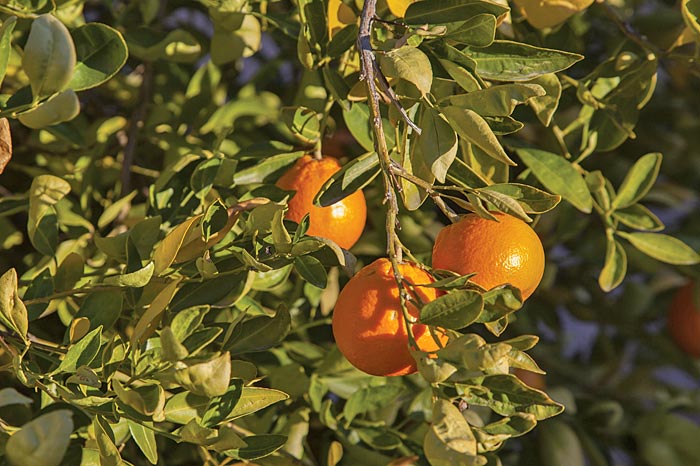Two CREC professors map out how certain varieties could hold the key to more HLB-tolerant citrus trees
FOR THOSE IN THE FLORIDA citrus industry, some say it’s the 11th hour. Citrus harvests are down 70 percent and a survey revealed an 80 percent rate of tree infection throughout Florida. However, the quest to find a long-term solution for the dreaded citrus greening disease may be approaching its final chapters — one that scientists at UF’s Citrus Research and Education Center (CREC) in Lake Alfred hope to help write the happy ending for.
ONCE UPON A TIME
According to plant cell genetics professor Dr. Jude Grosser, and professor of horticultural sciences Dr. Fred Gmitter, the story of the possible slaying of the citrus greening dragon starts with a tree propagated approximately two decades before citrus greening. “The cross was made before Dr. Gmitter and I arrived at the CREC,” Dr. Gosser observes.
“The original tree was one of a few hundred remaining from my predecessor, the majority of which did not produce fruit that were very good; but LB8-9 was immediately recognized as outstanding,” Dr. Gmitter explains. They got to work propagating LB8-9 — known as its trade name “Sugar Belle” — and conducting field trials as the tree exhibited a host of desirable traits. “It is a high quality tangelo similar to the Minneola ‘Honey Bell,’ but it matures slightly earlier in time for the Christmas market and has better external color,” Dr. Grosser says, adding the “flavor is exquisite.”
A TWIST IN THE STORY
However tasty Sugar Belle proved to be, it almost was the orange that wasn’t. “We released the variety at the WORST possible time in the history of Florida citrus,” Dr. Gmitter recalls, “just as HLB was beginning to explode in Florida.” With so much uncertainty, growers didn’t know what to do. Dr. Gmitter continues, “Very few growers wanted to make the leap into planting a new variety. Fortunately, a handful did and rode out the storm.”
Eventually, the high tolerance of LB8-9 to HLB could be seen, especially in Central Florida, one of the areas hit hardest by citrus greening. They refer to one tree as the “Mother Tree;” it stands in a grove at the CREC in Lake Alfred alongside its scions and other hybrids, many that show better tolerance than the original. As Dr. Grosser puts it, “We have Sugar Belle trees in commercial groves that have been infected with HLB for over eight years, yet they produce adequate yields of commercial, quality fruit year in and year out … as long as they are given the proper care.”
The Mother Tree and other hybrids don’t represent a cure, but a remedy. “The tree does get infected with the bacteria that causes HLB and it will show some of the symptoms that are typical for HLB,” Dr. Gmitter adds. “However, the trees seem to outgrow the disease. They do not die and decline like oranges will do.” And, as Dr. Grosser notes, with good care and nutrition, they will produce mostly normal fruit in abundance.
A CHANCE FOR A HAPPY ENDING
Sugar Belle trees are available, though, according to Dr. Gmitter, “as growers have become aware of the performance of LB8-9 now, there is a resurgence of interest in planting this variety, and nurseries are struggling to keep up with the demand.” The trees also require top-notch care to stay healthy.
There is also another hybrid that’s been newly released that’s worth talking about. “This current year we have released selection 7-6-27, also developed by Dr. Gmitter, and referred to as ‘Bingo’ by our growers,” Dr. Grosser states. “This selection is an easy-peel, seedless mandarin with excellent flavor that can easily compete with ‘Cuties’ and ‘Halos.’ The original tree is about eight years old and still free of HLB … so we’re keeping our fingers crossed that it will stay this way!”
However, both are varieties typically grown for fruit, not juice. Nevertheless, researchers believe these trees hold the secrets to creating HLB-tolerant citrus trees. “If we can understand how these varieties manage to beat HLB, we may be able to transfer that knowledge and information to other kinds of citrus,” Dr. Gmitter proposes. Every day brings them closer to saving Florida’s citrus industry. As Dr. Grosser indicates, “We expect our continued breeding efforts to generate additional new seedless fresh fruit and processing selections that have adequate HLB tolerance for sustainable and affordable production in Florida.”
At the end of the day, the knights are still questing, wielding science as their swords. “These new varieties do not provide a cure for the millions of trees already suffering from HLB,” Dr. Gmitter concludes, “but they hopefully can provide a bridge from the current dire situation back to a better one for Florida.”
CREDIT
article by ERIKA ALDRICH

